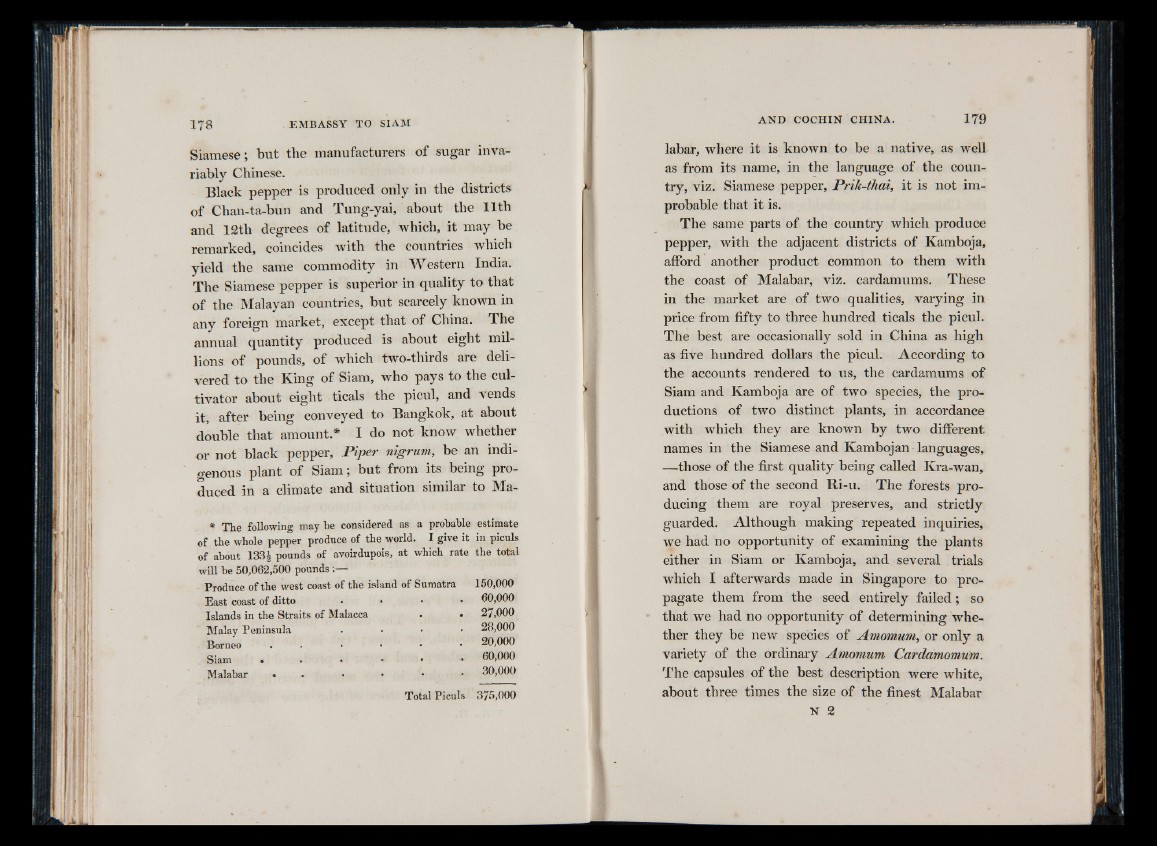
Siamese; but the manufacturers of sugar invariably
Chinese.
Black pepper is produced only in the districts
of Chan-ta-bun and Tung-yai, about the 11th
and 12th degrees of latitude, which, it may be
remarked, coincides with the countries which
yield the same commodity in Western India.
The Siamese pepper is superior in quality to that
of the Malayan countries, but scarcely known in
any foreign market, except that of China. The
annual quantity produced is about eight millions
of pounds, of which two-thirds are delivered
to the King of Siam, who pays to the cultivator
about eight ticals the picul, and vends
it, after being conveyed to Bangkok, at about
double that amount.* I do not know whether
o r not black pepper, Piper nigrum, be an indigenous
plant of Siam; but from its being produced
in a climate and situation similar to Ma*
The following may be considered as a probable estimate
of the whole pepper produce of the world. I give it in piculs
of about 133J pounds of avoirdupois, at which rate the total
will be 50,062,500 pounds :—
Produce of the west coast of the island of Sumatra 150,000
Past coast of ditto • • • • 60,000
Islands in the Straits of Malacca . . 27,000
Malay Peninsula . . . . 28,000
Borneo . . . . . 20,000
S i a m .......................................................................... 60,000
Malabar • • • • • • 30,000
Total Piculs 375,000
labar, where it is known to be a native, as well
as from its name, in the language of the country,
viz. Siamese pepper, Prik-thai, it is not improbable
that it is.
The same parts of the country which produce
pepper, with the adjacent districts of Kamboja,
afford another product common to them with
the coast of Malabar, viz. cardamums. These
in the market are of two qualities, varying in
price from fifty to three hundred ticals the picul.
The best are occasionally sold in China as high
as five hundred dollars the picul. According to
the accounts rendered to us, the cardamums of
Siam and Kamboja are of two species, the productions
of two distinct plants, in accordance
with which they are known by two different
names in the Siamese and Kambojan languages,
—those of the first quality being called Kra-wan,
and those of the second Tti-u. The forests producing
them are royal preserves, and strictly
guarded. Although making repeated inquiries,
we had no opportunity of examining the plants
either in Siam or Kamboja, and several trials
which I afterwards made in Singapore to propagate
them from the seed entirely failed ; so
that we had no opportunity of determining whether
they be new species of Amomum, or only a
variety of the ordinary Amomum Cardamomum.
The capsules of the best description were white,
about three times the size of the finest Malabar
N 2